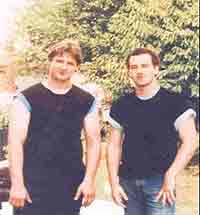

Chicago Gaylords
Discover the historical account of the Chicago Gaylords, one of the most well-known gangs in the city. Explore their evolution from a social club in the late 1940s to a greaser gang in the 1950s, and their growth into the largest white gang in Chicago. Uncover the experiences of white youth walking the streets of Chicago in the 1970s and 1980s as we delve into the history and significance of the Chicago Gaylords.
Origins and Growth of the Chicago Gaylords
From a social club in the late 1940s to a greaser gang in the 1950s, The Gaylords became a force to be reckoned with. From the 1960s on, the Gaylords spread throughout the City of Chicago.
Chicago Gay Lords' Name
In 1950, the name "Gay" meant "Happy" and the name "Lords" meant "Kings". The name meant: Happy Rulers! No, the Gaylords had no link to the Gaylord Box company.
The Chicago Gaylords: A Snapshot of the 1950s and 1980s
The Gaylords' origin started from two (S.A.C.) Social Athletic Clubs in 1950: Gaylords SAC on Polk and Miller, in the Taylor Street area.; the Gaylords' Social Athletic Club in the Grand and Ogden area, which was affiliated with the Junior Postal Athletic Club, and is located in the Little Italy section known as the Patch.
Explore what it took to walk the streets of Chicago as white youth in the 1950s and 1980s. Gain insights into the existence of Chicago street gangs and witness how the Gaylords grew from a neighborhood street gang in the 1950s into the largest white gang in Chicago.
The Chicago Gaylords, assumed to be a North Side Street Gang, had sections on the South Side in Sherman Park (55th and Ashland), 18th and Western (Pilsen area), and Bridgeport (Throop Street).
Chicago Gaylords Gang Sections
The Chicago Gaylords, assumed to be a North Side Street Gang, had sections on the South Side in Sherman Park (55th and Ashland), 18th and Western (Pilsen area), and Bridgeport (Throop Street).
Colors and Origins
Gang colors: Black and light blue: all sections started by Kilbourn Park; Black and Gray: all sets started by Palmer Street; Black and Brown: all sections started by 18th and Western on the South Side.
Books and Resources
Two non-fiction novels have been written about the Chicago Gaylords street gang: Great American Youth and Lords of Kilbourn written by Rocker, a former Lawndale and Altgeld and Kilbourn Park Gaylord.
Chicago Gaylords Documentary - Great American Youth - Chicago Gaylords on Facebook Chicago Gaylords | Facebook
Chicago Gaylords Gang: Message Board
New Novel: " GAYLORDS OF KILBOURN"... HERE (Press Link): Gaylords of Kilbourn
Who Runs Chicago?
In the book "Who Runs Chicago?" published in 1979 by authors Michael Kilian, Connie Fletcher, and F. Richard Ciccone, it is documented that during that era, the Chicago Gaylords gang held a significant presence in the city. According to the book's account, the Chicago Gaylords were identified as the fourth-largest street gang in Chicago, boasting a membership that spanned thousands both on the streets and within the Illinois prison system. This historical reference sheds light on the gang's prominence within the city during the late 1970s, providing valuable insight into the dynamics of street gangs in Chicago during that time.
Chicago Gaylords Influences
Dean Ford and The Gaylords, a band from the 1960s that later became known as The Marmalade, adopted their initial name, "The Gaylords," with an intriguing connection to the Chicago Gaylords gang. This choice of name added an enigmatic edge to their band identity. The Chicago Gaylords was a prominent gang in Chicago during that era, known for their influence and notoriety. By incorporating "Gaylords" into their name, the band tapped into the mystique surrounding this infamous group. It's a fascinating twist that adds a unique layer of history to the story of Dean Ford and The Gaylords, who eventually went on to achieve success in the music industry under their new moniker, The Marmalade.
Oldest Newpaper Articles in all Four Chicago Newspapers of Modern Gangs
The two oldest newspaper articles found in the four Chicago daily publications: Egyption Cobras gang, West Side, 1954; Gaylords gang, Shedd Park gymnasium 2300 South Lawndale Avenue, gang fight between the Gaylords and the Outlaw Street gang, March 1954.
International Gaylords
Gaylords sections have been reported in Indiana, Wisconsin, Iowa, Florida, and Edmunton Alberta, Canada.


